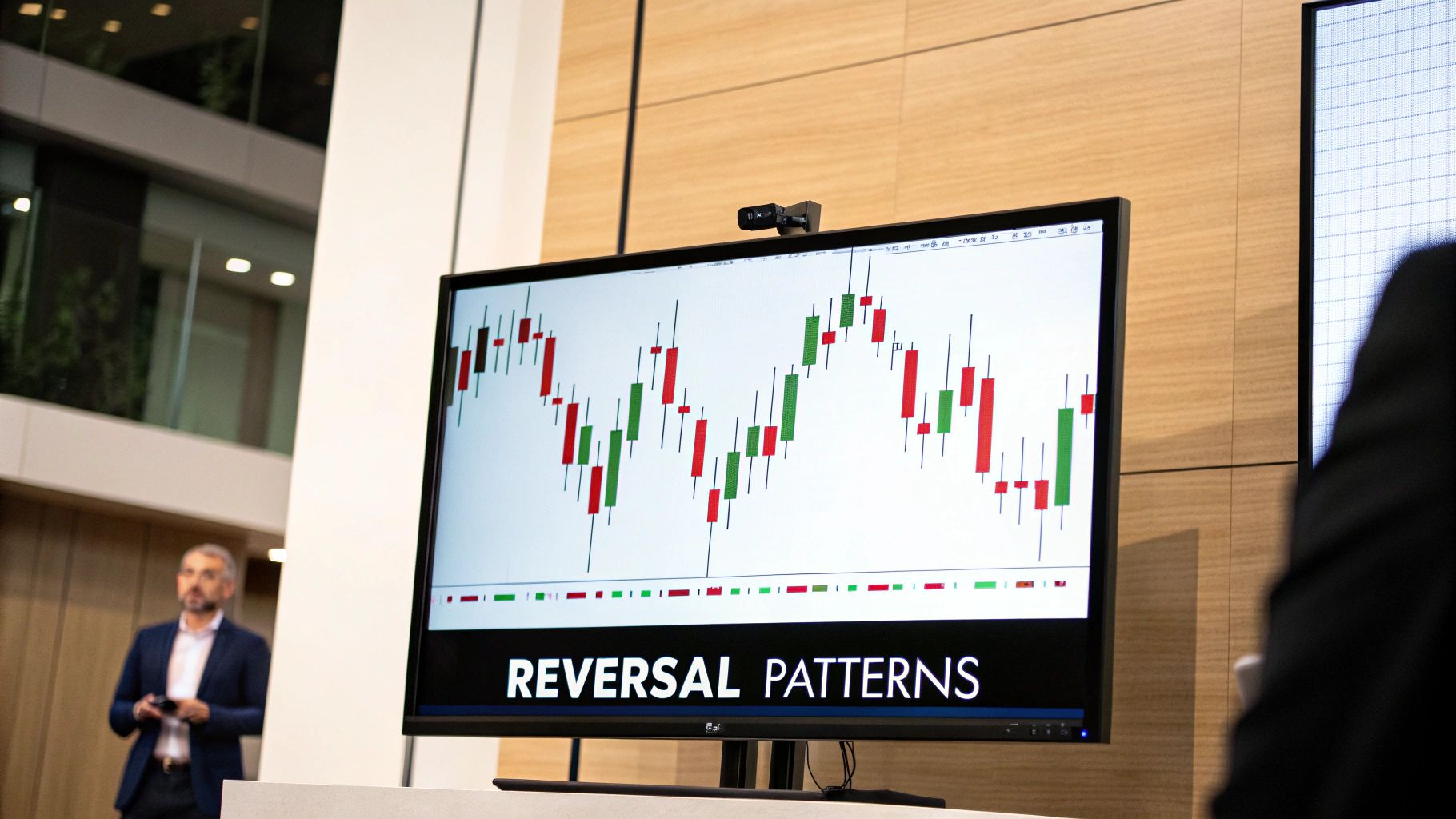Day trading chart patterns are visual roadmaps of a stock’s price movements. Think of them as the footprints left behind by the constant tug-of-war between buyers and sellers. We’ve all felt the emotional rollercoaster of trading — the hope, the fear, the frustration. These patterns help us step back from that noise and look at the market more objectively.
These formations often give us clues about where the price might be headed next, signaling whether a trend is likely to continue its path or reverse course entirely. Getting a handle on them is a cornerstone skill for anyone serious about reading the market’s mood, but remember, they are tools for managing probability, not crystal balls guaranteeing profits.
Learning to Read the Market’s Story

Welcome to the chaotic, exhilarating world of day trading. Every chart you pull up is telling a story — a real-time narrative of the battle between bullish conviction and bearish pressure. It’s easy to see just a bunch of jagged lines and flashing numbers, and feel completely overwhelmed. But there’s a language hidden in that chaos.
That language is made up of recurring shapes and formations. These are the chart patterns that can tip you off to what might happen next.
Don’t think of them as infallible signals that predict the future with perfect accuracy. Instead, see them for what they are: a visual representation of market psychology. They show us moments of doubt, surges of confidence, and signs of exhaustion among traders. Learning to spot them is like learning to read a map of supply and demand — an absolutely essential first step. If you’re just starting out, getting familiar with how to read stock charts will give you the foundational context you need before going deeper.
The Foundation of Pattern Analysis
At its heart, chart pattern analysis is really just the study of human behavior. We’re looking for repeatable actions that show up as specific shapes on a price chart. But let’s be clear: no pattern works 100% of the time. The path to becoming a consistent trader is often paved with frustration and learning from mistakes. It’s a journey that requires immense patience.
The real goal isn’t to find some mythical, foolproof signal. It’s to identify high-probability setups where the potential reward justifies the risk you’re taking.
This takes serious discipline and a long-term perspective. Instead of chasing every hot tip or trying to get rich quick, successful traders build a systematic process. They identify a pattern, execute the trade, and manage their risk based on what the chart is telling them, not what their emotions are screaming.
Trading is a game of probabilities, not certainties. Your job is to find an edge, manage risk, and execute your plan with unwavering discipline, regardless of the outcome of any single trade.
The Two Core Types of Day Trading Patterns
To start making sense of it all, we can break down every chart pattern into two main categories. Understanding what each type is trying to tell you is the first step toward using them effectively in your own trading.
Here’s a quick breakdown to get you started:
| Pattern Type | What It Signals to Traders | Common Examples |
|---|---|---|
| Continuation Patterns | These suggest a temporary pause in the current trend. It’s like the market is taking a quick breather before heading further in the same direction. | Flags, Pennants, Rectangles, Ascending/Descending Triangles |
| Reversal Patterns | These indicate that an existing trend is running out of steam and might be about to change direction entirely. | Head and Shoulders, Double Tops/Bottoms, Wedges, Cup and Handle |
Spotting a continuation pattern can help you find an opportunity to jump into an existing trend. On the other hand, identifying a reversal pattern early can be your cue to take profits on a current trade or even enter a new position as the momentum shifts.
How to Spot Trend Continuation Patterns
Imagine you’re watching a stock that’s on a tear, climbing higher and higher. Then, all of a sudden, it stops. The upward march pauses, and the price starts moving sideways. Is the party over? Not necessarily. More often than not, this is just the market catching its breath before continuing the climb.
These pauses are what we call trend continuation patterns. For a day trader, they can present opportunities to jump into a trend that’s already in motion. They form during a brief period of consolidation — some traders are cashing out and taking profits, while new traders are getting in, setting the stage for the next big move. Your job is to read the story the chart is telling, wait for confirmation of a breakout, and manage your risk accordingly.
Decoding Flags and Pennants
Two of the most common continuation patterns you’ll see are Flags and Pennants. They might look a bit different, but they tell a very similar story. Both show up after a sharp, almost vertical price move that traders call the “flagpole.” Think of the flagpole as the initial burst of buying or selling pressure.
Once that big move happens, the price consolidates:
- Bull and Bear Flags: These are small, rectangular channels that actually slope against the main trend. So, in a strong uptrend, you’ll see a bull flag that drifts slightly downward. In a downtrend, you’ll see a bear flag that angles up.
- Pennants: These look like small, symmetrical triangles that form right after the flagpole. The price bounces between two converging trendlines, signaling that volatility is shrinking as the market winds up for its next leg.
The psychology behind these is pretty straightforward. After a big, fast move, the market needs a moment to digest what just happened. The slight counter-move of a flag or the tightening range of a pennant shows a minor tug-of-war, but the eventual breakout tells you who won.
The diagram below gives you a simple breakdown of how these common patterns fit together.
As you can see, patterns like Triangles and Flags are classic examples of formations that suggest an existing trend may have more room to run.
Mastering Triangle Patterns
Triangles are another family of powerful continuation patterns. They signal a similar consolidation period but often take a little longer to develop than flags or pennants. The real key here is to watch how the price interacts with the support and resistance trendlines.
There are three main types to watch for:
- Ascending Triangle: You’ll spot this one by its flat, horizontal resistance line on top and a rising support line below. This is a classic bullish setup. It shows that buyers are getting more aggressive, pushing the price up to test that same resistance level over and over until it finally breaks.
- Descending Triangle: This is the mirror opposite. It has a flat support level on the bottom with a descending resistance line squeezing the price down. It’s typically bearish, signaling that sellers are in control and are about to push the price through a key support floor.
- Symmetrical Triangle: Here, you have two converging trendlines — one going down, one going up — that meet at a point. This pattern is pure indecision. The breakout could go either way, but it will often resolve in the direction of the original trend.
Patience is the ultimate virtue when trading continuation patterns. Rushing to enter a trade before the pattern fully forms and confirms a breakout is one of the most common and costly mistakes a day trader can make.
Trading becomes far more objective when you have data to back up your decisions. A great way to build confidence is to analyze how these patterns have performed in the past to understand their statistical likelihood of success. This shifts your approach from pure guesswork to a more calculated, data-driven process. For another tool to help confirm trend direction, check out our guide that explains https://tradereview.app/blog/how-to-use-moving-averages/.
Identifying Powerful Trend Reversal Patterns

If continuation patterns are the market taking a quick breather, reversal patterns are the big, flashing stop sign. They’re a warning that a solid trend is running out of steam and a major change of direction could be right around the corner. We’ve all been there — holding a winning trade just a little too long, only to watch it turn on a dime and eat up our profits.
Learning to spot these formations early is a huge part of protecting your capital and, just as importantly, catching the next big move. These day trading chart patterns aren’t just random shapes; they tell the story of a battle between buyers and sellers where one side is finally getting exhausted. For us, that’s a signal to sit up and pay attention.
The Head and Shoulders Pattern Explained
The Head and Shoulders is one of the most classic signals that a trend might be about to reverse. You’ll usually see it pop up at the top of an uptrend, signaling a potential shift from bullish to bearish. Think of it as the bulls’ last gasp — their final, failed attempt to push prices higher before sellers take over.
The pattern has three key peaks:
- Left Shoulder: A solid price peak, followed by a small pullback.
- Head: A second, higher peak. This is the last big push from buyers.
- Right Shoulder: A third peak that’s lower than the head, showing the bulls just don’t have the strength to make a new high.
The “neckline” is a simple support line you can draw connecting the low points between the peaks. The potential trade signal occurs when the price breaks below this neckline. That breakdown suggests the sellers may have won the fight. A flipped, upside-down version of this pattern can also signal a bottom in a downtrend.
Reading Double Tops and Double Bottoms
A little simpler, but no less powerful, are the Double Top and Double Bottom patterns. These are often easier to spot because they represent a very clear test of a major price level.
A Double Top looks like the letter “M” and shows up at the end of an uptrend. It forms when the price hits a resistance level, pulls back, then rallies right back to that same level — only to get rejected again. That second failure to push higher is a huge clue that buying pressure is fading.
On the flip side, a Double Bottom looks like a “W” and forms after a downtrend. The price drops to a support level, bounces, and then falls back to test that exact same support level again. When the price holds that second time and starts to climb, it’s a strong sign that sellers have lost control and buyers are stepping in.
Reversal patterns are a story of failure. A Head and Shoulders pattern is the story of bulls failing to make a new high. A Double Top is the story of buyers failing to break resistance. Understanding this narrative is key to trading them effectively.
A Practical Trading Strategy for Reversals
Seeing the pattern is one thing, but actually trading it requires a game plan. Let’s walk through a Double Top as a practical example of how you could build a trade around one of these signals.
- Identify the Pattern: You see a stock in a strong uptrend hit a new high at $105, dip back to $102, then rally back to $105 and stall out.
- Confirm the Signal: The confirmation you’re waiting for is a breakdown below the support level formed by that dip — in this case, $102.
- Plan Your Entry: A common approach is to place a short-sell order once the price closes clearly below that $102 support line. This tells you the pattern is officially in play.
- Set Your Stop-Loss: To keep your risk in check, you could set a stop-loss just above the resistance at $105. If the pattern fails and the price breaks out instead, your loss is small and defined.
- Project a Profit Target: A standard way to estimate a target is to measure the height of the pattern (from the $105 peaks down to the $102 support, which is $3) and subtract that from your entry point. This gives you a potential target of $99 ($102 – $3).
This kind of methodical approach takes the emotion out of it. You’re forced to define your risk and your potential reward before you ever click the “sell” button, which is the cornerstone of disciplined trading.
Using Volume and Time for Better Trades
Spotting one of the classic day trading chart patterns is a great start, but it’s only half the battle. A pattern without context is just a pretty shape on your screen, and trading on shapes alone is a fast track to getting chopped up by the market. To really gain an edge, you have to think like a detective, piecing together multiple clues before putting your capital at risk.
Two of the most powerful clues you have are volume and time. These elements give you the context you need to decide if a pattern is a high-probability setup or just random market noise. Think of volume as the fuel behind a price move — without it, even the most textbook-perfect pattern can fizzle out and fail.
Why Volume is Your Best Friend
Volume simply measures how many shares are being traded. It’s a raw look at conviction. When a stock breaks out of a bull flag on a massive surge of volume, it’s a clear signal that a crowd of traders is aggressively pushing the price higher. That’s the confirmation you’re looking for.
On the other hand, if a stock trickles below the neckline of a Head and Shoulders pattern on weak, fading volume, you should be extremely skeptical. This is a classic “falseout” trap. The move lacks commitment and could easily snap right back in the other direction.
High volume is your green light on a breakout — it signals strong participation and conviction. Low volume during a breakout is a major red flag, telling you the move probably doesn’t have the momentum to follow through.
Getting a feel for volume is crucial for any strategy, but it’s especially important if you’re diving into approaches like momentum trading, where conviction is everything.
Timing Your Trades with Market Tendencies
Just as important as what is happening is when it’s happening. The time of day can have a huge impact on how reliable a pattern is. A pattern that forms during the chaotic, high-volume market open (the first 30-60 minutes) will behave much differently than one that shows up in the quiet, low-volume midday session.
For instance, morning breakouts tend to have more power behind them because more people are trading. Patterns that form during the midday lull, however, can be choppy and much more likely to fail.
Beyond that, some stocks have their own unique intraday habits. A trader might notice that a particular stock tends to reverse around the same time every afternoon. You can spot these tendencies by watching a stock’s behavior over several weeks. Paying attention to these rhythms, as detailed on sites like TradeThatSwing.com, adds another layer of confirmation to your trade ideas and helps you sync up with the market’s daily flow.
Building a Trading Plan Around Chart Patterns
Spotting day trading chart patterns is a huge step, but it’s only half the battle. Here’s a tough lesson every trader learns: seeing a perfect setup and actually making money from it are two very different skills. This is where your real work begins — turning that pattern recognition into a repeatable, disciplined trading plan.
Without a plan, you’re just gambling. A professional trader defines their rules of engagement before even thinking about clicking the buy or sell button. This simple act transforms pattern spotting from an emotional coin flip into a methodical process. It’s what bridges the gap between being a chart analyst and becoming a consistently profitable trader.
Defining Your Rules of Engagement
Think of your trading plan as your personal rulebook. It’s designed to take emotion out of the equation, forcing you to act on what the chart is telling you, not what your gut is screaming.
For every single pattern you trade, your plan needs to spell out your entry and exit criteria with zero ambiguity.
Let’s say you’re looking at a bull flag. A solid plan might look something like this:
- Entry: I’ll only go long after a full candle closes above the flag’s upper trendline, and it must be on higher-than-average volume. No exceptions.
- Exit (Profit): My first profit target is a move equal to the height of the flagpole, measured up from the breakout point.
- Exit (Loss): My stop-loss goes right below the low of that breakout candle. If the pattern fails, I’m out with a small, manageable loss.
This level of detail is your best friend when the market is moving fast. It kills hesitation and silences that in-the-moment panic. You’ve already done the hard thinking. Now, you just execute.
The Psychology of Execution
Even with the world’s best trading plan, your biggest opponent is often staring back at you in the mirror. The mental pressure of day trading can trigger some seriously destructive habits, like FOMO (fear of missing out) and revenge trading. We’ve all been there — jumping into a trade too early because you’re scared to miss the move, or making a huge, reckless trade to “win back” the money you just lost.
Your best defense against this self-sabotage? A trading journal.
By logging every trade — the pattern, your reasoning, the outcome, and how you felt — you create an honest, data-driven feedback loop. It forces you to look your mistakes squarely in the face and doubles down on what’s actually working.
A trading plan without a journal is like a map without a compass. The plan shows you the path, but the journal keeps you from wandering off course when your emotions try to take over.
At the end of the day, a data-backed approach is what separates the amateurs from the pros. Big-shot firms like JPMorgan pour resources into analyzing decades of historical data, all to find consistent patterns and sharpen their edge. You can bring that same professional mindset to your own desk. By analyzing your personal trade data, you start building a strategy that’s robust and tailored to you. To see this in action on a massive scale, check out how JPMorgan searches for patterns in market data.
Common Questions About Chart Patterns
Even after staring at charts for hundreds of hours and learning dozens of day trading patterns, it’s completely normal to have questions. The jump from theory to trading with real money is a big one, and it always brings up new uncertainties. Let’s tackle some of the most common questions traders have.
Which Chart Pattern Is the Most Reliable?
This is the holy grail question, isn’t it? But the truth is, there’s no single “best” pattern. How reliable a pattern is depends entirely on the market, the specific stock, and the timeframe you’re trading. A bull flag might work like a charm in a strong uptrend but will probably fail miserably in a choppy, sideways market.
Instead of hunting for one perfect pattern, it’s far better to master two or three that really click with your trading style. A trader who’s great at spotting reversals might focus on Head and Shoulders and Double Tops. Another might build their entire strategy around Ascending Triangles.
Success comes from mastery, not memorization.
How Do I Avoid Getting Faked Out by a False Breakout?
False breakouts are one of the most maddening things in trading. The pattern looks perfect, the price punches through, you jump in… and then it slams back down, stopping you out for a loss. You can’t eliminate them completely, but you can definitely learn to sidestep most of them.
The single best defense is to always wait for confirmation.
A breakout without a big spike in trading volume is a warning sign, not an entry signal. Patience is your greatest ally here; let the market prove the move is real before you risk your capital.
Wait for a candle to close decisively above the breakout level, and make sure it does so on strong volume. This simple filter will keep you out of so many weak moves designed to trap eager traders.
What Timeframe Should I Use to Find Patterns?
The right timeframe really boils down to your personal trading strategy. If you’re a day trader aiming for quick, intraday moves, the 5-minute and 15-minute charts are usually the sweet spot. They give you enough detail to see clear patterns without all the random noise you get on a 1-minute chart.
But here’s a pro tip: patterns on higher timeframes (like the hourly or daily) carry a lot more weight. A breakout on the 15-minute chart is good, but if it lines up with a bigger bullish pattern on the hourly chart, your trade has a much higher probability of working out.
Ready to stop guessing and start analyzing? TradeReview gives you the tools to track every pattern, identify what’s working, and eliminate costly mistakes from your strategy. Ditch emotional trading and build a data-driven edge with our free trading journal. Get started today at https://tradereview.app.


